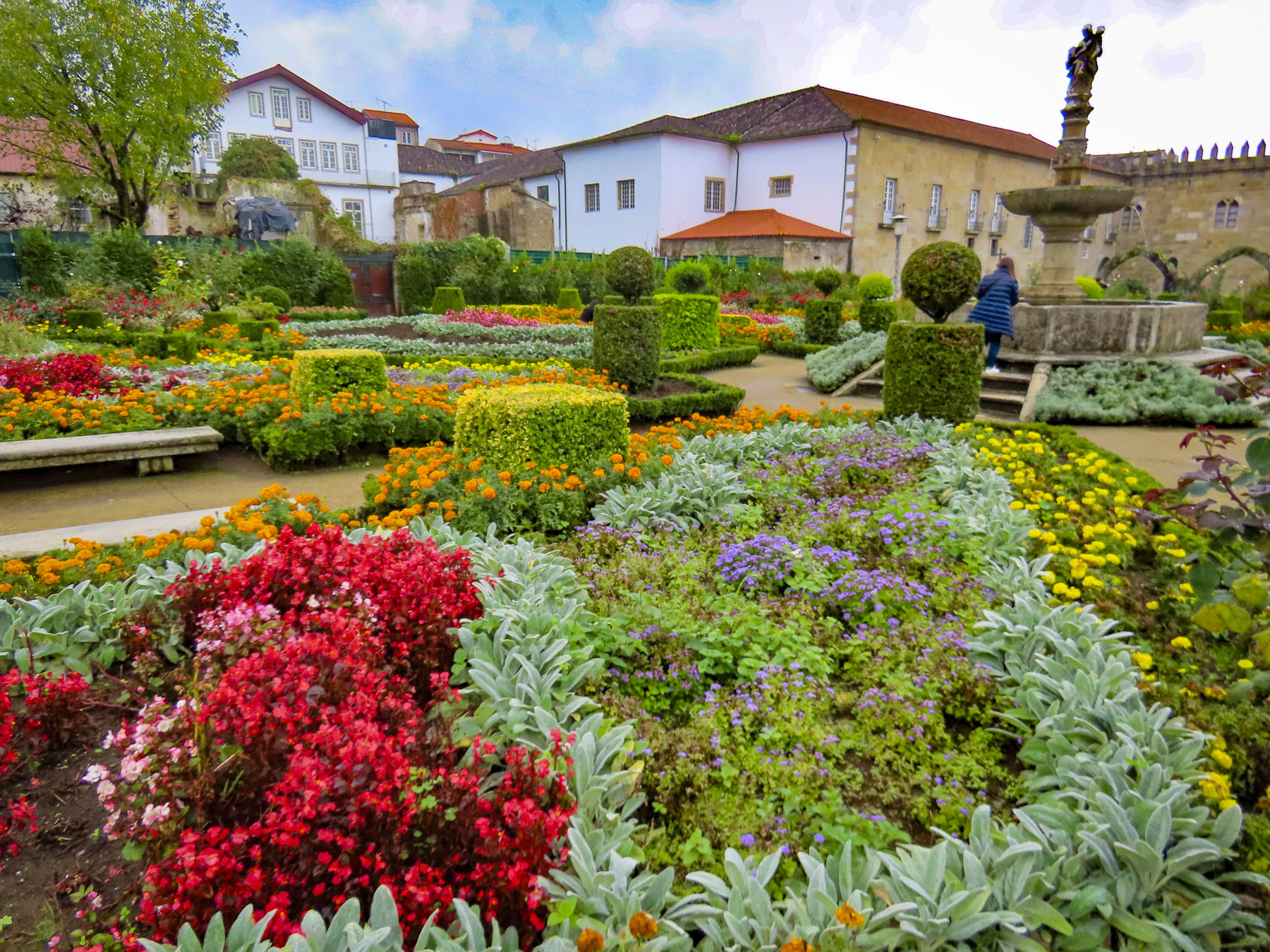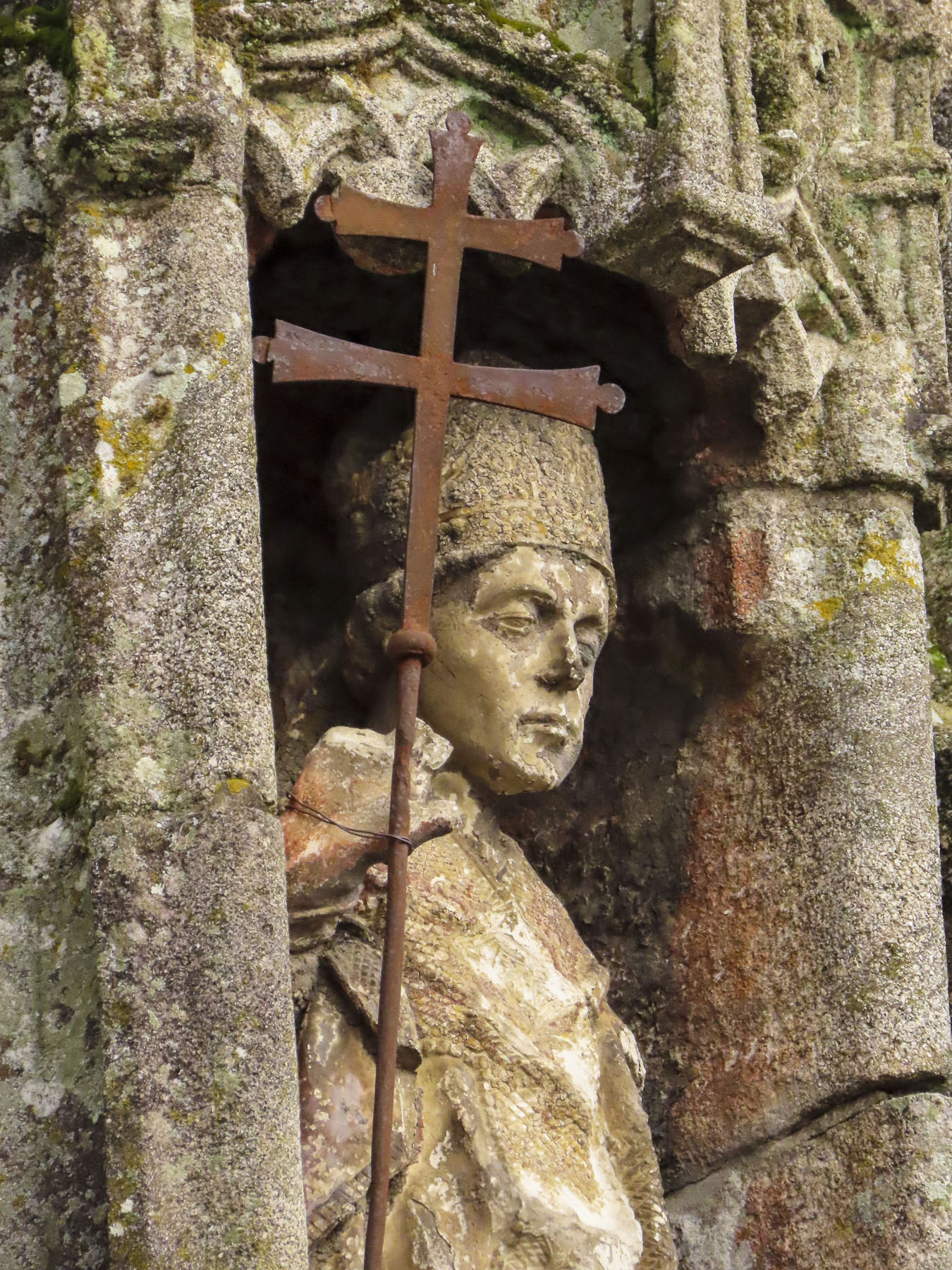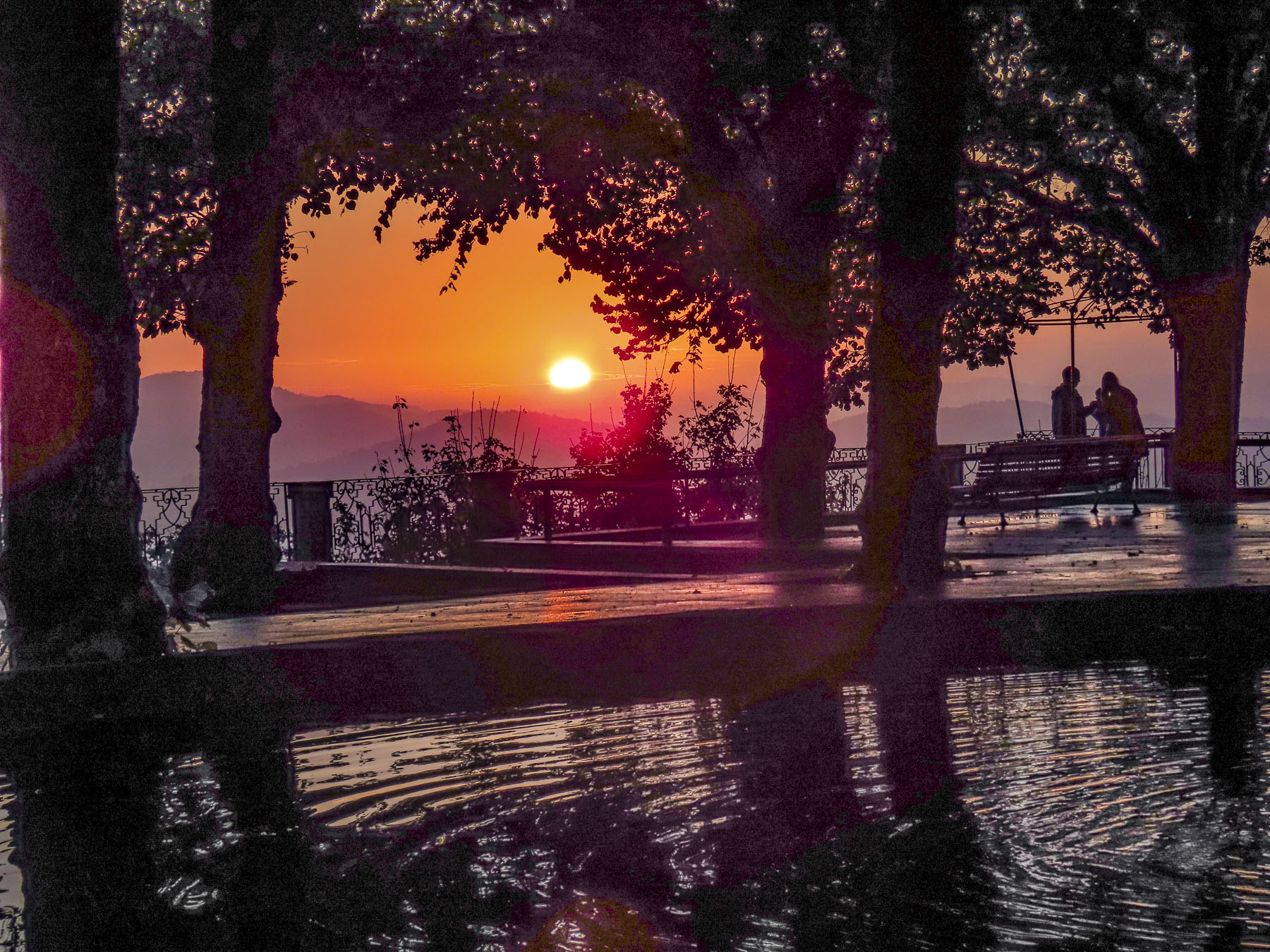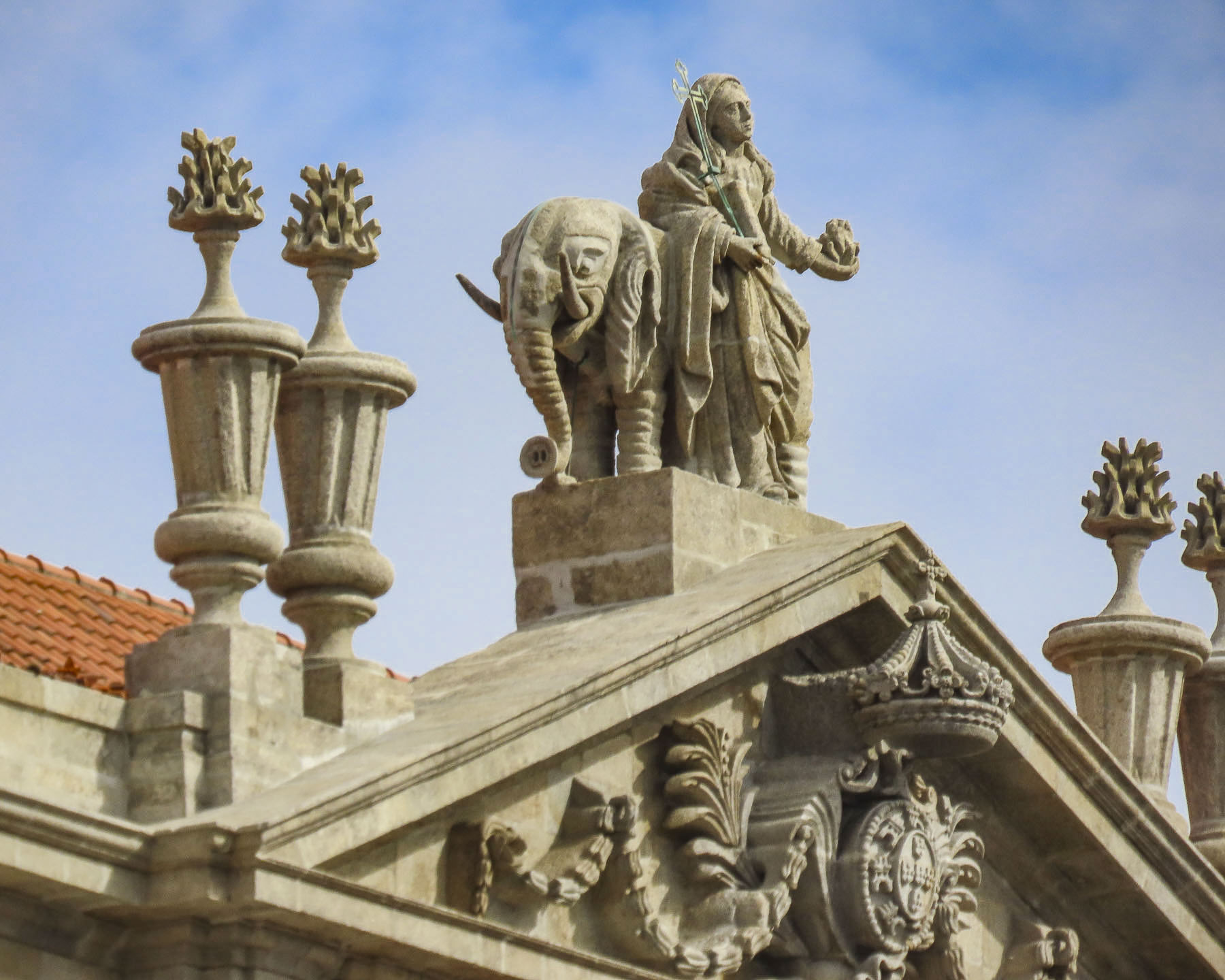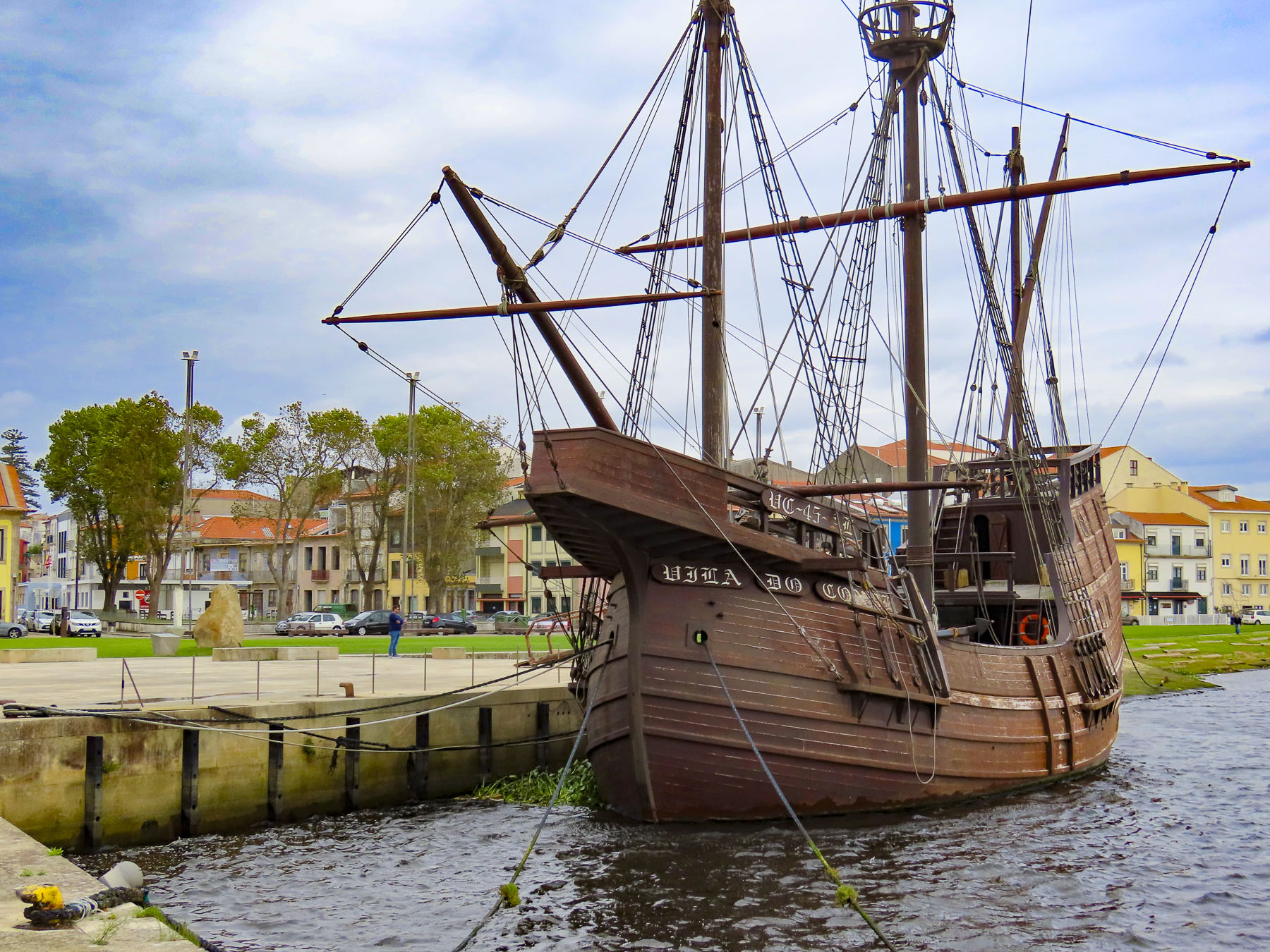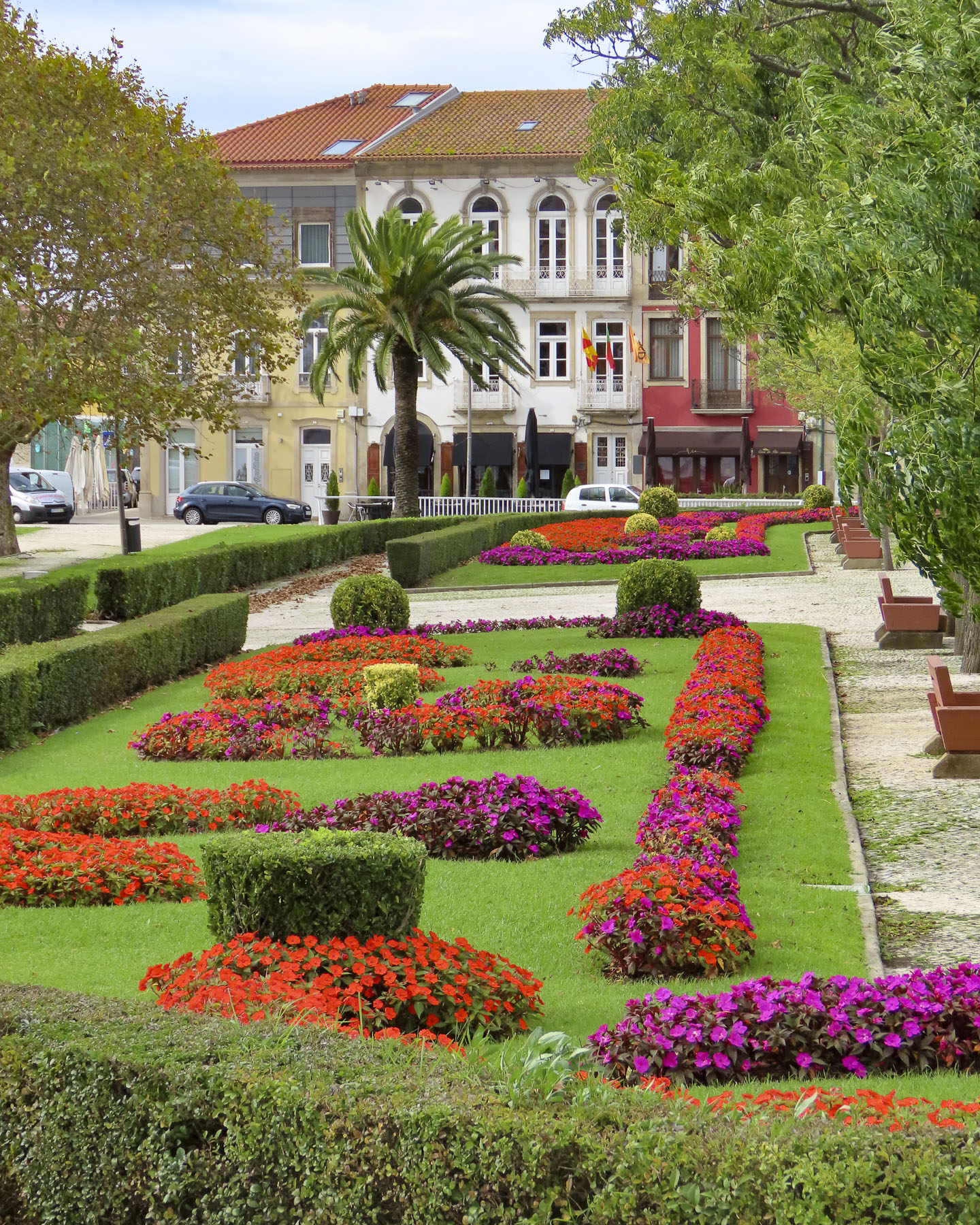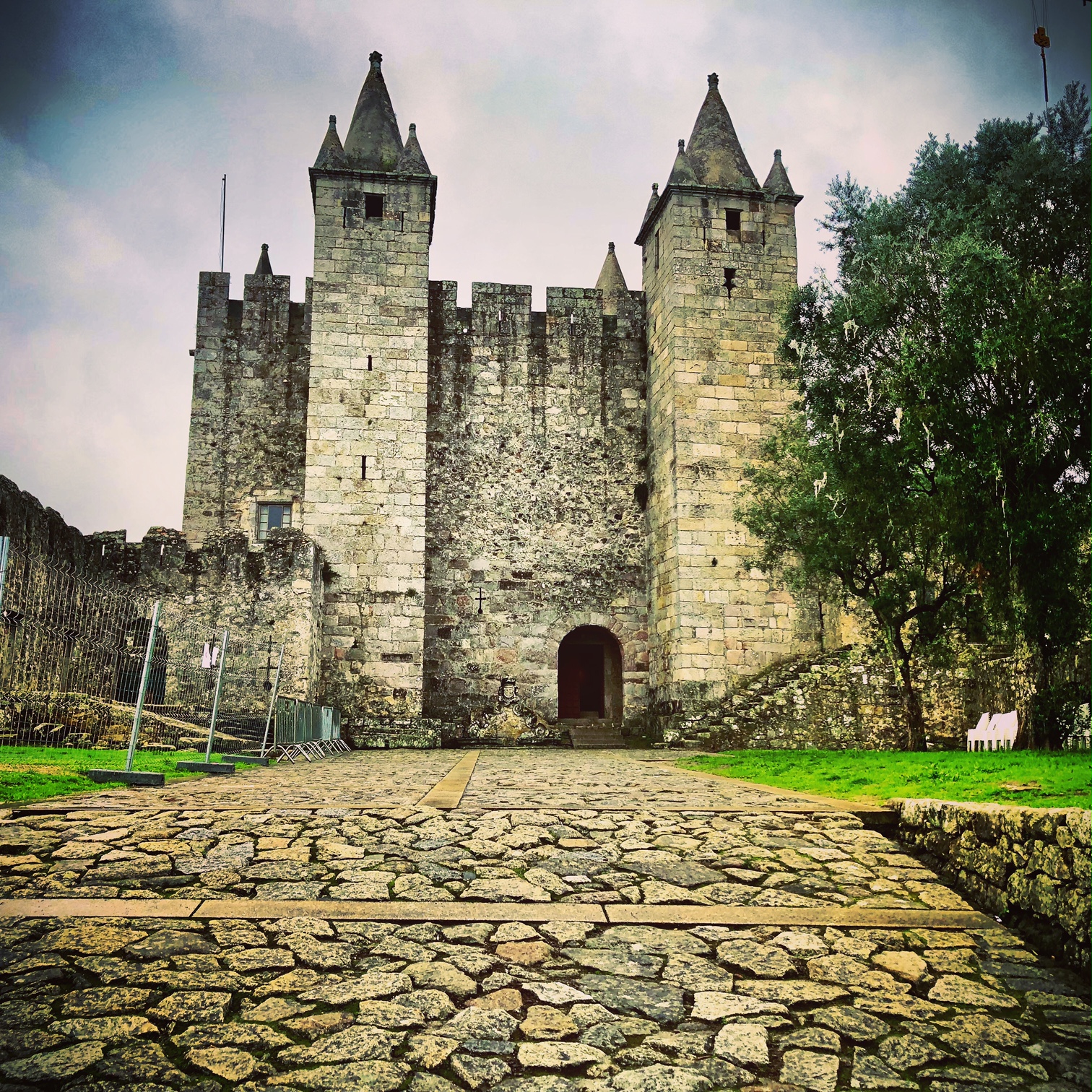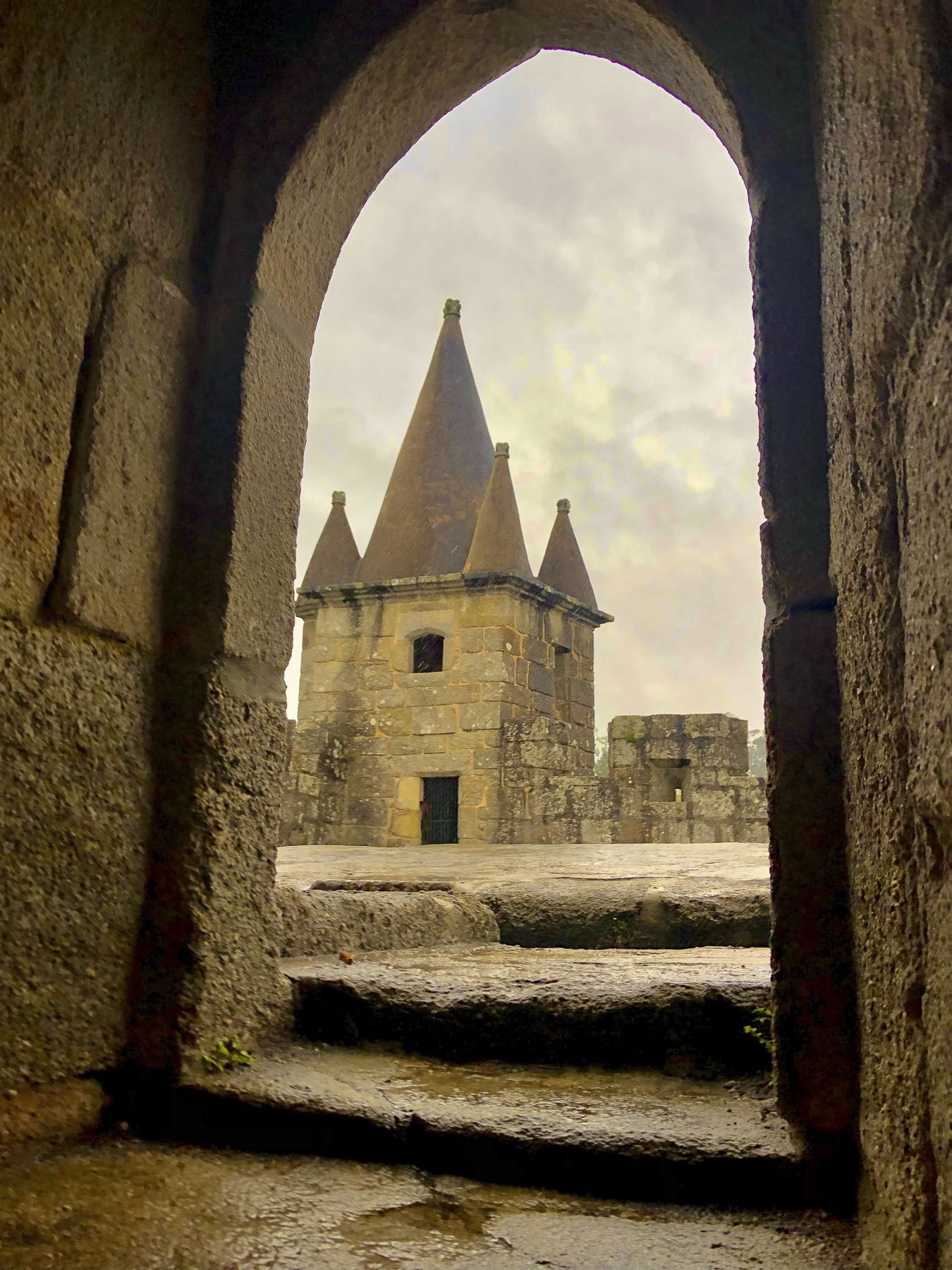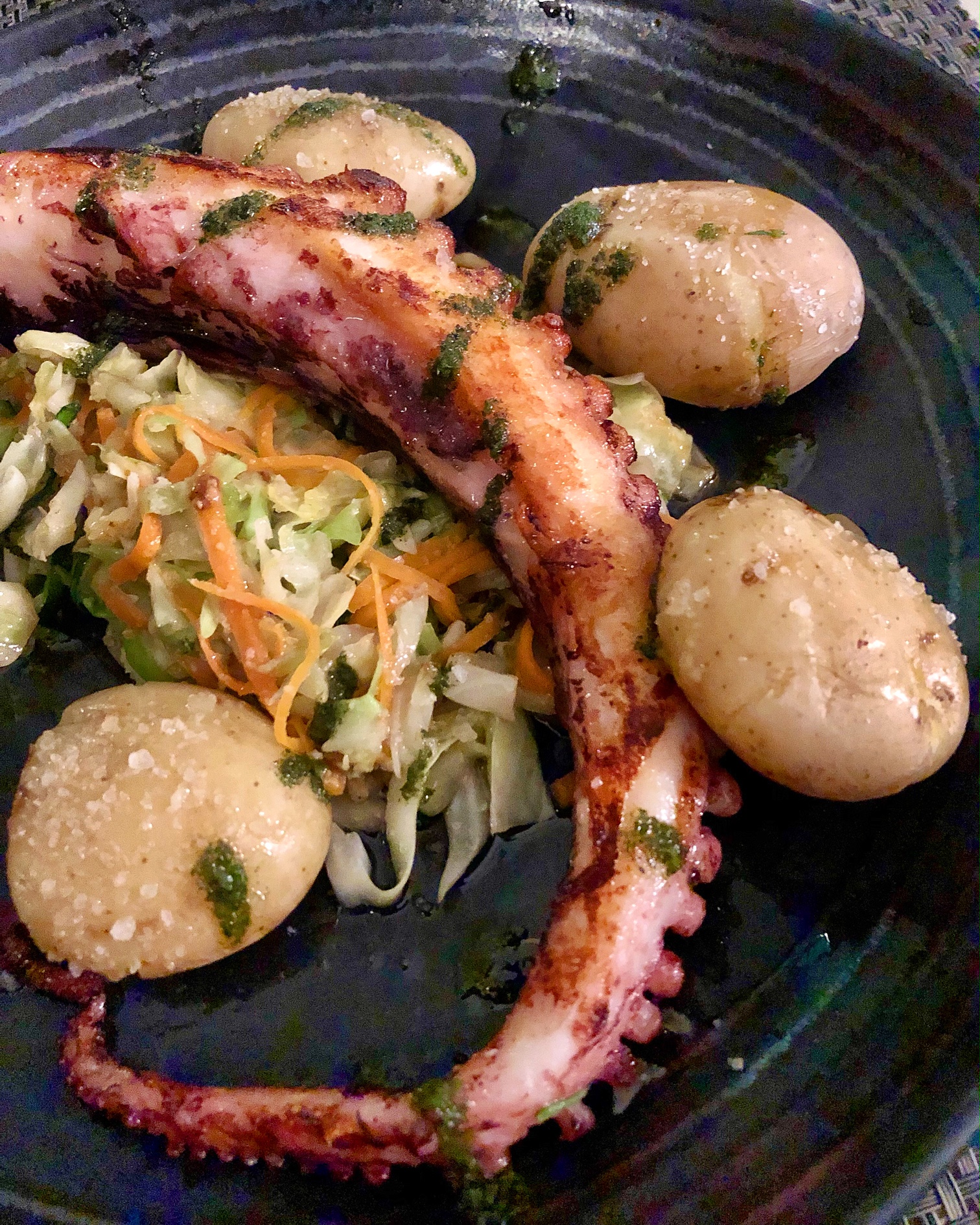Let’s face it, sometimes the weather just sucks! It was so abysmal we were tempted to stay wrapped in our blankets and sip coffee, but our travel plans dictated otherwise. We try to avoid really long drives, but sometimes you just have to. Today was one of those days. Six hours of driving from Santa Maria de Feira across the country, west to east, to the Portuguese frontier. Stopping at Castelo Mendo then heading south to Sortelha Castle before reaching Castelo de Vide, where we would spend the next two nights. We had visited this region bordering Spain several years earlier, exploring Marvão, Monsanto and Castelo Branco, and found the quiet walled villages and hilltop castles intriguing and full of fascinating history.

Normally we like to use Google Maps’ “avoid tolls” filter, because tolls along with gasoline are excessively expensive in Europe. We’ve followed its suggested routes to some off-the-beaten-path discoveries; however, this time it doubled the length of the journey. So, we kept to the highways. In Lisbon we had asked the car rental agent about paying tolls which eventually boiled down to: you need to stop at any CTT Post Office, give the agent your car registration number and pay the tolls only for the dates you have rented the car. It was actually an easy and inexpensive process.


The intermittent rain had stopped, but a moody gray sky still hung over Castelo Mendo as we walked through the Portas da Vila, the ancient gate, guarded by two towers and two now well-eroded zoomorphic sculptures of wild boar, which are believed to date from an early Iron Age settlement. Solid two-story homes lined the way. The first floors, now shops closed for the off-season, were once used as barns for animals, while the upper levels were used as living space for the families. Our footsteps echoed down the hard stone alleys as we made our way to the hill where the castle once stood, we passed the communal oven, the pillory, and the portal to a foundling wheel (a turnstile where unwanted babies were anonymously placed. It was used until 1867.)


On the ruins of earlier Bronze Age and Roman fortresses a large castle, with six city gates and two rings of defensive walls and towers, was ordered built in 1229 by D. Sancho II. It must have been a sight to behold as the village was granted a charter to host an eight-day-long triannual fair. This was the first fair to be held on a regular basis in Portugal. The castle’s strategic importance was soon forgotten after the permanent border with Spain was established in 1297 with the Treaty of Alcanizes, and over time the immense walls were dismantled. The stones were carted away to build homes in the expanding and prosperous village. Now on the crest of the hill only the ruins of the citadel’s church remain standing.


We were navigating a switchback curve off of N324 which we had followed south from Castelo Mendo when we spotted the Castle of Sabugal high on knoll above the Coa River. Looking very impressive from a distance, we noted the castle for future travels. The weather too inclement to stop on the shoulder of the road to take a photo.

The storm had steadily worsened all afternoon. By the time we reached the Castelo de Sortelha it was raining “estava chovendo cães e gatos.” Fortunately, it was mid-week and every sane person was inside with their feet by the fire enjoying a glass of port. Except for this “madman,” which is how my loving wife occasionally refers to me.

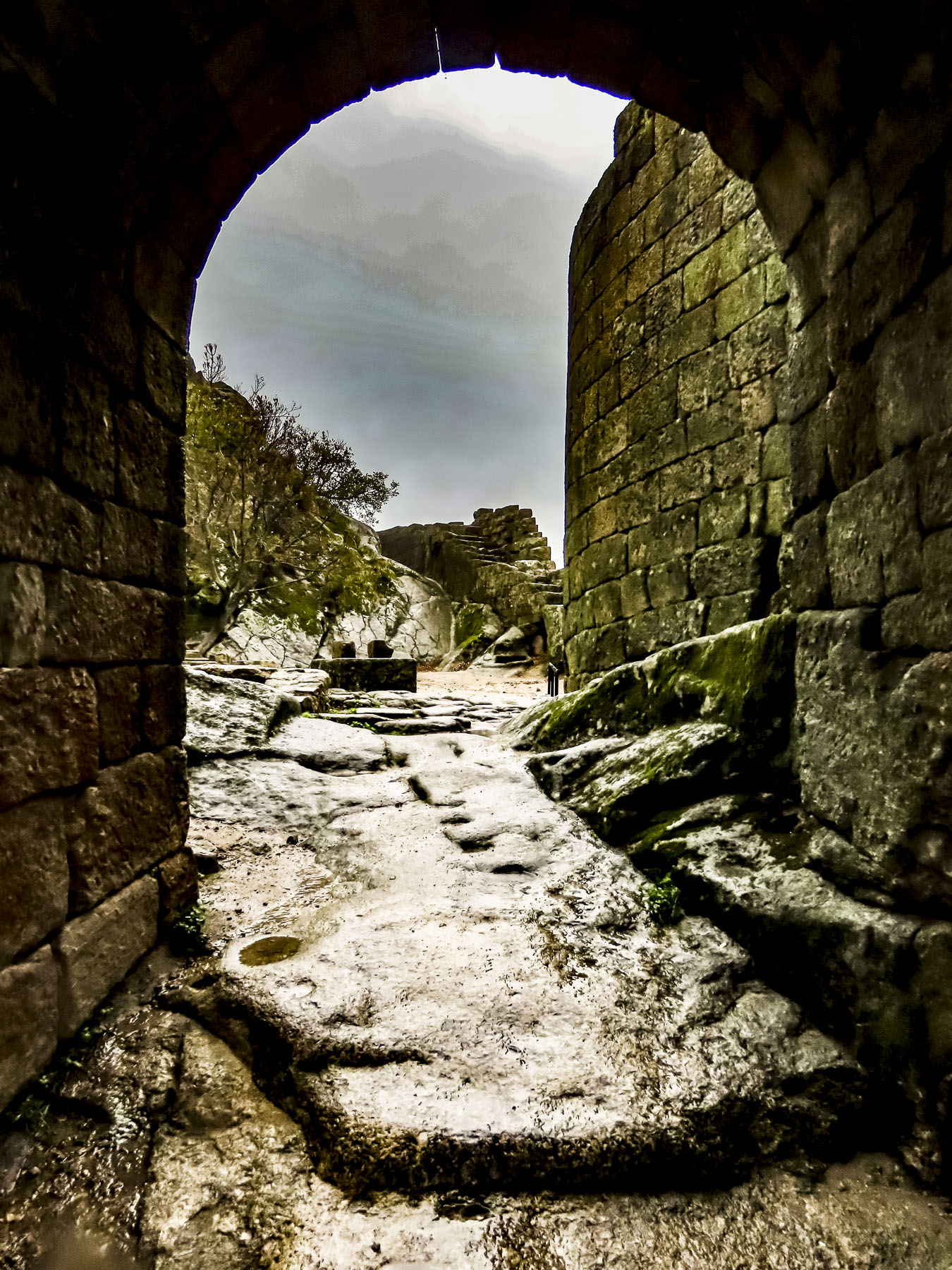

I’ve always enjoyed weather and spent three years before retirement, as a mailman delivering mail in all sorts of weather. “Neither snow nor rain…” I was unfazed. Donna sat out this lunacy. But you never know if you’ll get a chance to come back! Tucking my camera deep under my coat, I ventured forth. I returned soaked. Really it was just an excuse for a double ration of Port that evening. To say the least, the photos are moody.


Fortunately, the door was quickly opened at A Burguesa Guesthouse and a friendly voice welcomed us with “Please come in, let me take your bags,” as we were ushered inside out of the rain. We know we’re getting older when the young receptionist at the guesthouse whisked our bags up the stairs two steps at a time. “Maybe I should start dying my grey?” “You might need to shave a few years off while you’re at it,” Donna replied jokingly with a smile. A few moments later the hostess returned with an umbrella and directions for parking our car which was blocking the narrow, deserted lane in front of the guesthouse.


“Follow the lane, anywhere around the plaza, the parking is free.” One of the things we’ve come to appreciate while driving through Portugal is that parking, outside of the larger cities, is relatively easy and free. Unlike Italy where you practically need to have a separate budget just to park the car. When I returned our hostess kindly offered to dry our coats for us, which we greatly appreciated. Originally a large family residence with a workspace on the lower level, A Burguesa was lovingly restored into a spacious inn featuring eight guest rooms, pool, terrace and views of the village’s castle.



Castelo Vide first came to our attention several years ago, when we were driving north from Marvao to Castelo Branco. Its red roofed, white stuccoed buildings and prominent castle covering a hillside looked so appealing we hoped to return. We did detour at the time to the Ermida de Nossa Senhora da Penha, a small chapel in a cork forest. Located high on a ridge opposite the village, it offered an outstanding view. If the weather is nice, it’s definitely worth a visit. Farther along there is still visible on this lane a section of old Roman road that crossed this region 2000 years ago.
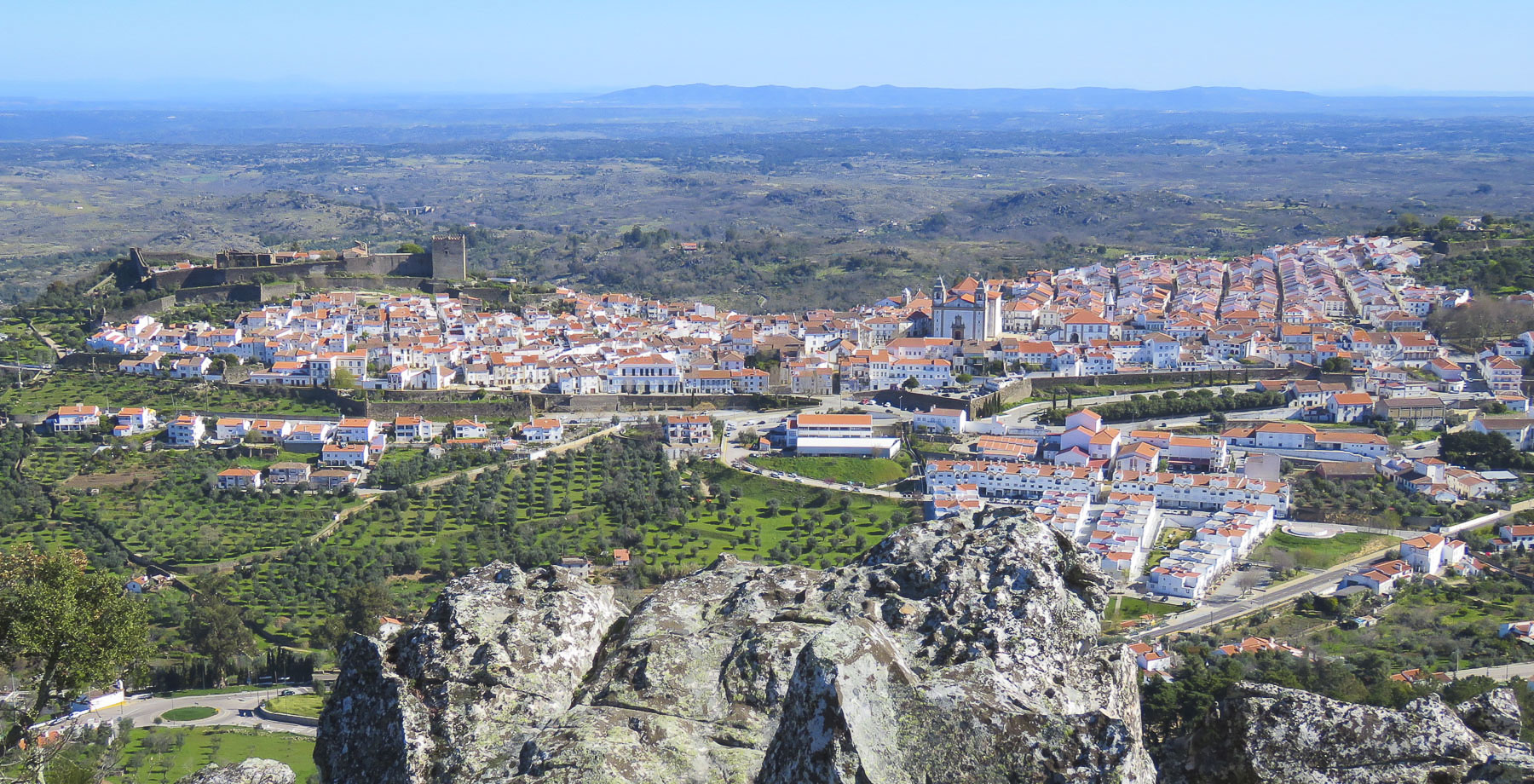
Vide, as it was known before its castle was built, has been an important town since the Romans settled the area in 44 BC, when it was a vital stop on the trade route between Merida, Spain and the Atlantic coast. Eventually the Moors ruled the area from the 7th until 12th century. It wasn’t until 150 years after the Reconquista in 1310 that King Dom Dinis ordered a new castle built, and the growing town became Castelo Vide.


This castle is where King Dinis negotiated his marriage to his future queen, Isabel of Aragon. The castle still commands the hilltop today, though now the medieval fortress has been renovated into a museum and civic center. At the time we visited it showcased an interesting exhibit about Portugal’s Carnation Revolution in 1974, which ended a forty-year military dictatorship.

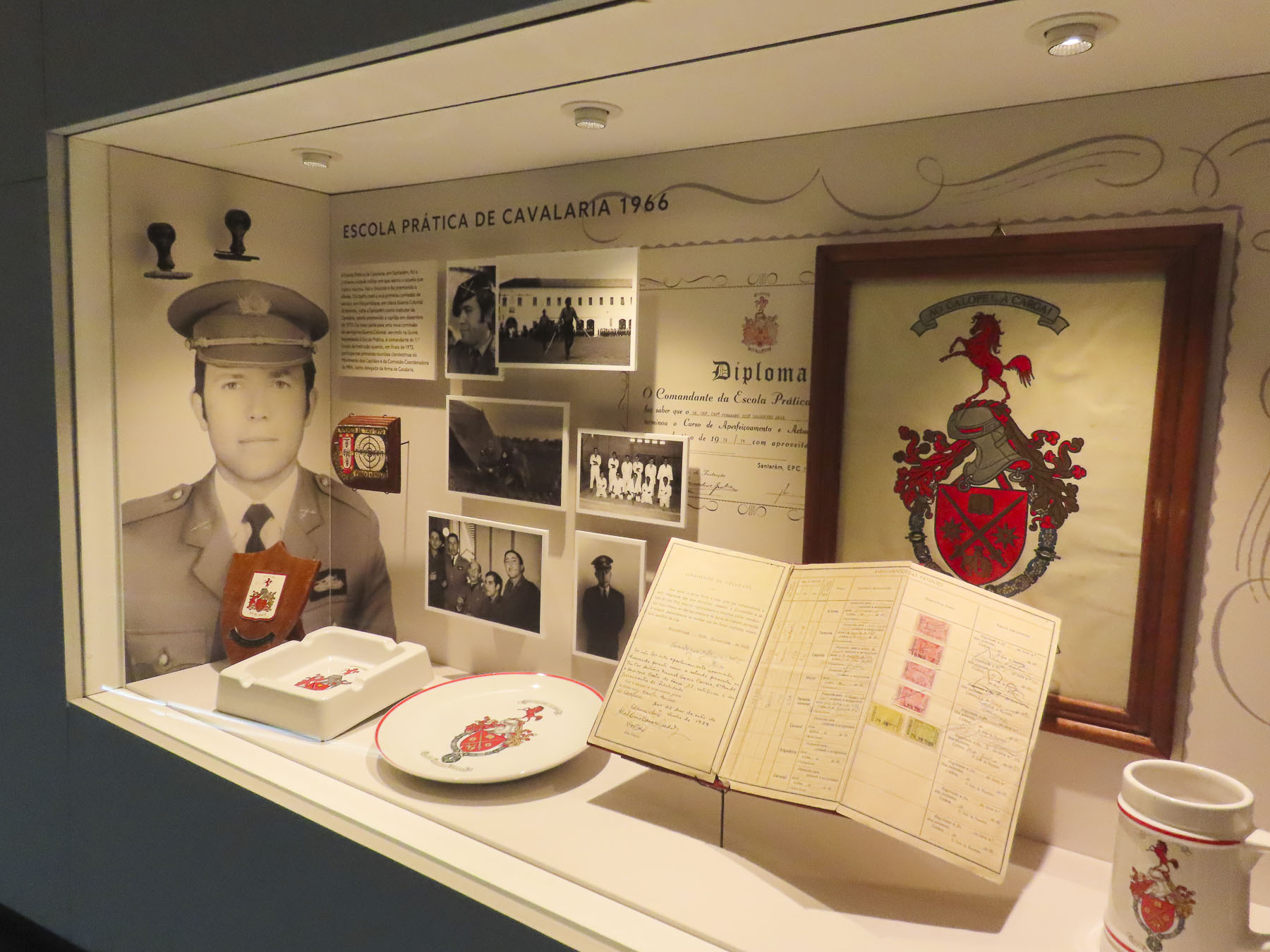

Seven hundred years ago the homes of the walled enclave that surrounded the castle keep represented a medieval who’s who of wealthy merchants influential enough to secure shelter behind the fortress walls. The intimate narrow passageways and ancient archways of this still inhabited enclave were intriguing to wander through.


On the slope below the castle, steep alleys spiderweb down the hillside. While it was a vigorous trek to the top, the descent was equally challenging, with the concern that if we lost our balance on the wet cobblestones, we would bounce downhill like soccer balls. I exaggerate only slightly. The ambiance of this neighborhood was equally interesting – flowers seemed to grow from solid rock in the crevasses between street and homes. On homes in this neighborhood, Gothic style granite casings still survived and framed many doors and windows. Some homes left doors ajar for family pets to wander in and out, or to share their parakeets’ songs with the neighbors.

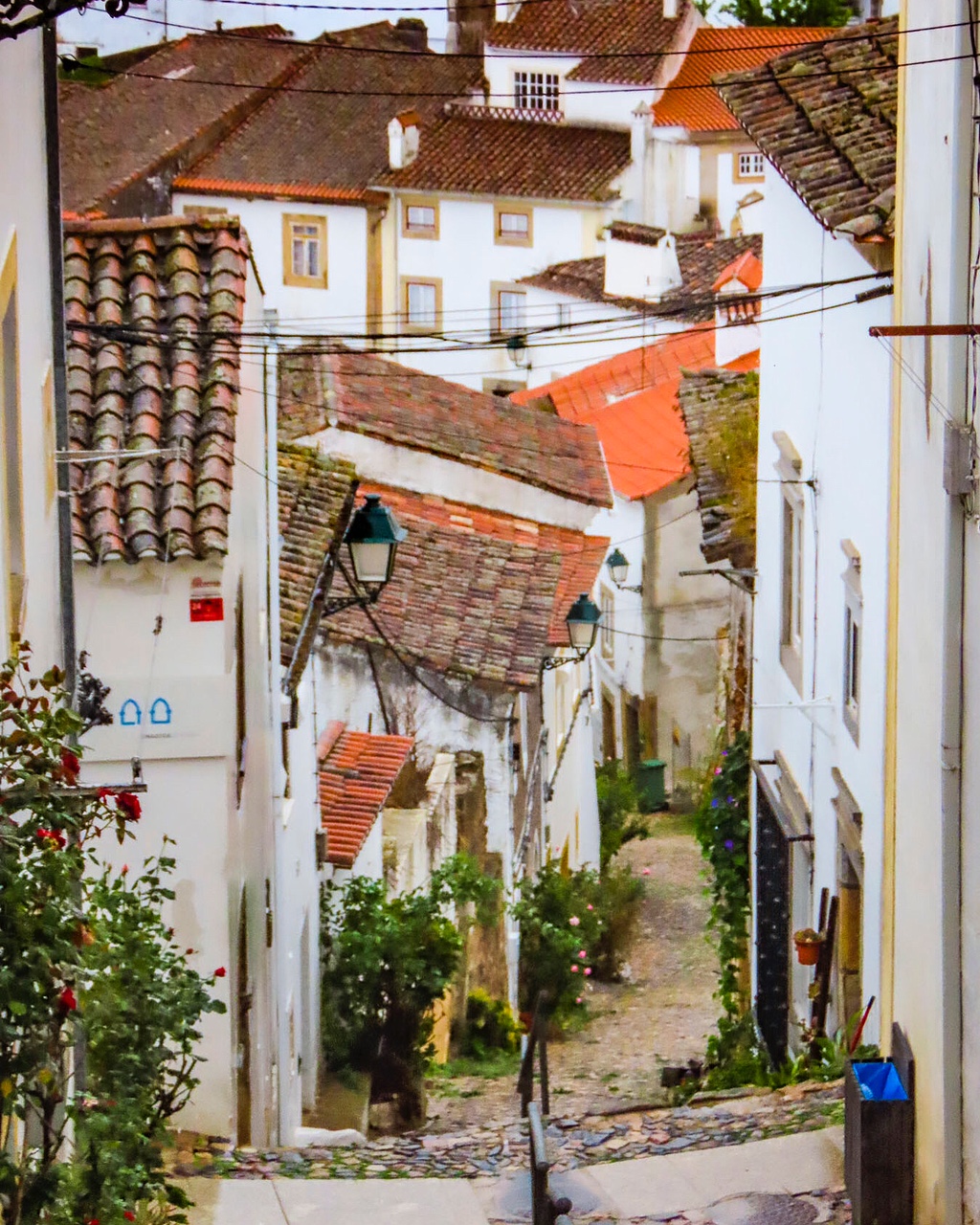

We followed a lane across the slope to Sinagoga de Castelo de Vide, a residence before its use as a modest Jewish temple. It’s thought to be one of the oldest existing pre-expulsion synagogues in Portugal, that dates from the 13th century. It’s now a museum that chronicles Jewish life in the region. Vide’s Jewish Quarter expanded significantly after Spain expelled its Jewish citizens in 1492. While Portugal was more tolerant of their religion, they were still required to live apart and encouraged to convert to Christianity.

At the bottom of the Jewish Quarter, the Fonte da Vila, a marble sixteenth century Renaissance fountain, centers the village’s old market square. The mineral water flowing from it was renowned for allegedly curing a variety of ailments from diabetes to high blood pressure.

The narrow lanes of the old town eventually funnel into the Praça Dom Pedro V, a stately plaza featuring the town hall and Igreja Matriz Santa Maria da Devesa. These “newer” historic buildings and the homes on the surrounding wider streets date from the town’s prosperous 17th and 18th centuries.


While the interior of the town’s church is very modest, the old choir loft, balconies and bell towers have been converted into a simple museum displaying a wealth of ancient religious art and sculpture. If you have ever wondered what happens to the contents of all the small, abandoned parish churches you’ve driven past, here’s your answer. Well, hopefully they end up in a splendid museum like this one that has become the religious art repository for the region. A gem of a discovery and the perfect way to spend a wet afternoon for only 1€.




The next morning a favorable weather report promising sun encouraged us as we continued south to Evora. Only a few miles out from Castelo Vide we detoured for a quick stop at the Ponte Romana da Portagem. A modest four-arched stone bridge, built in the 1400s over an earlier Roman crossing, its tranquil location spanning the Sever River obscures a turbulent past. It was here that King John II of Portugal built a tower with a tollgate in front of the bridge to collect a tax from the Jewish people expelled from Spain. A small refugee camp grew along the riverbank for those who couldn’t afford the tax. It’s believed 15,000 Jewish refugees eventually crossed the bridge.



The high arches of an ancient aqueduct, the Aqueduto da Água de Prata, spanned our route into Evora. This was a critical infrastructure project in the 1500s when King John III ordered it built to relieve the near constant drought conditions of the city that was quickly becoming a center of commerce and education in the Alentejo region, with the establishment of the Colégio del Espiritú Santo, University of Evora, in 1557. Of Lisbon’s Tower of Belém fame, military architect Francisco de Arruda was chosen to design the aqueduct. The mammoth project stretched a formidable 11 miles from the Divor River through a series of tunnels and over elevated arches, some 85 feet tall, spanning valleys and plains, before bubbling forth in the public fountains across Evora. Seems “location, location, location,” has been a housing mantra for centuries and as available land within the walled city disappeared, homes and stores were built under the aqueduct’s arches.
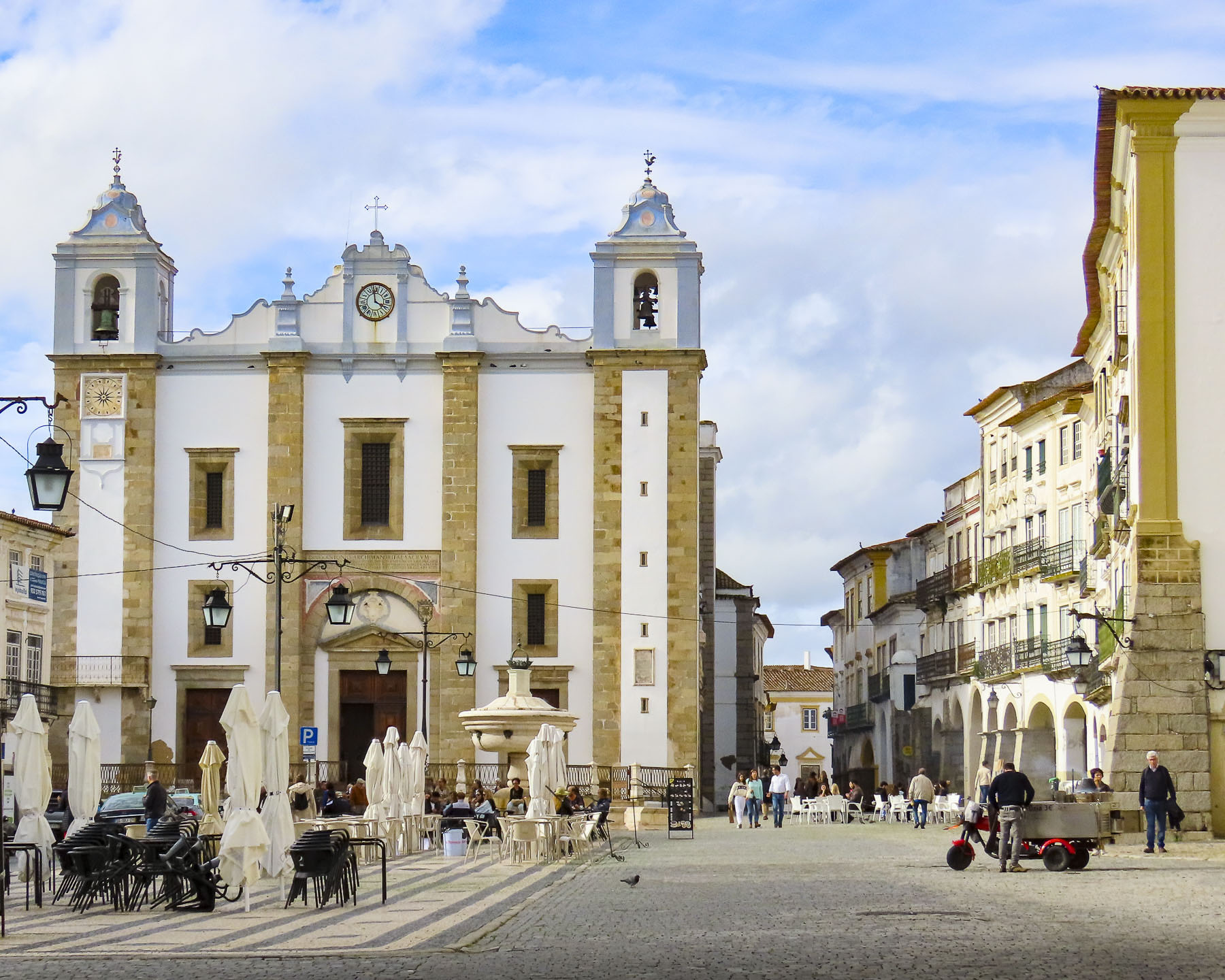

We knew when we planned this trip that parking in Evora would be an issue, but we were fortunate to find The Noble House which had a limited number of parking spaces available for 10€ a day. It wasn’t going to break our budget and it was well worth the convenience for two nights. The 24-room boutique hotel, as its name suggests, was in the 1400s an aristocrat’s family home. The hotel has been meticulously renovated to a historical standard that kept many of the building’s original stone arches, azulejos tiles and vaulted brick ceilings in place. For the level of comfort provided, and the convenient location, it was a tremendous value. During the shoulder season rooms are often available for under 100€ per night, breakfast included.



Wandering through the ancient city, we were charmed by its ambience, and the way in which archaic architectural styles harmoniously blended. At the city’s center, Roman first century ruins of the Temple of Diana share the acropolis with the 14th century gothic Catedral de Évora, the largest medieval church in Portugal.
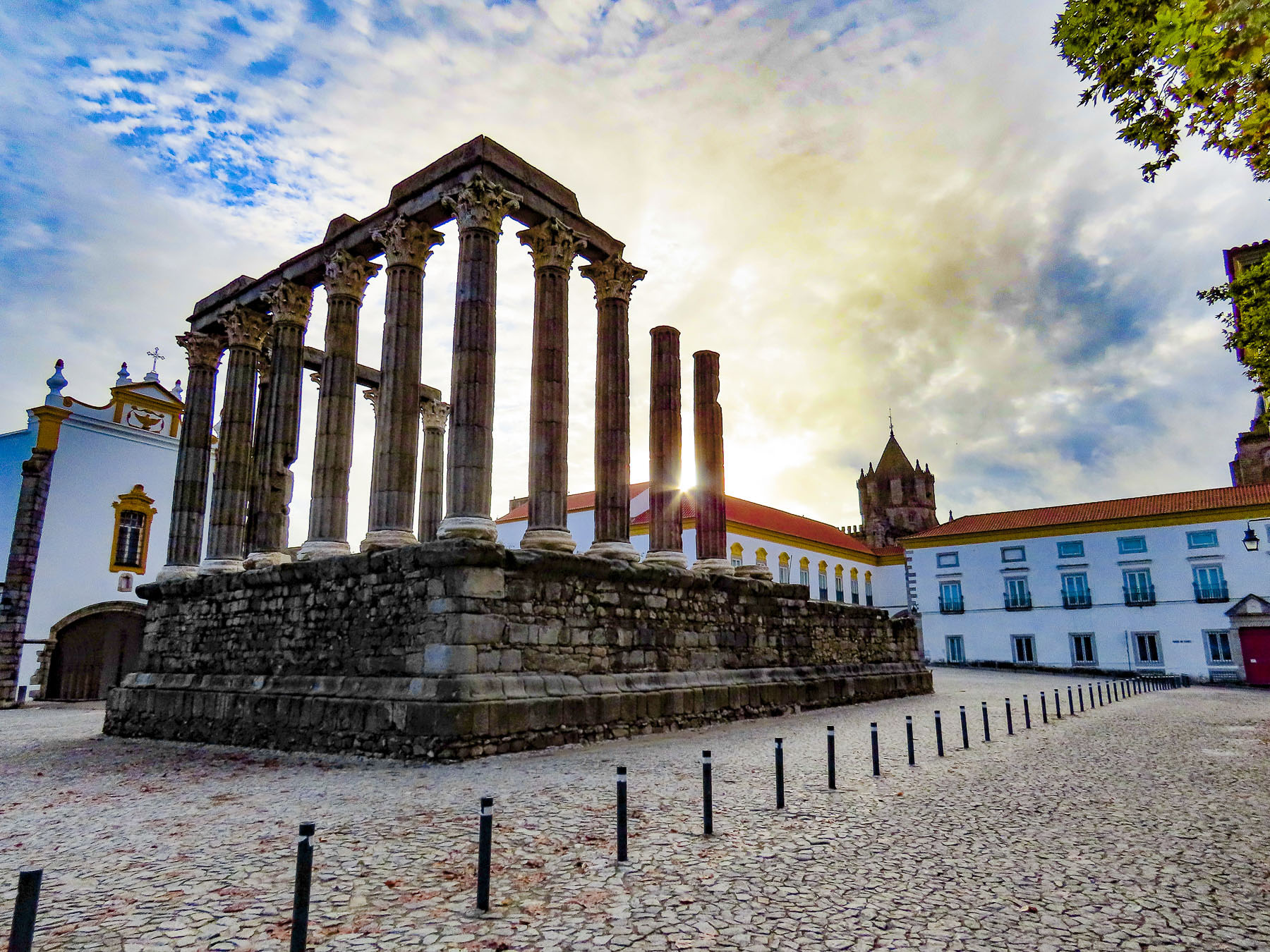

We climbed to the cathedral’s roof, the highest point in Evora, for brilliant panoramas of the city.

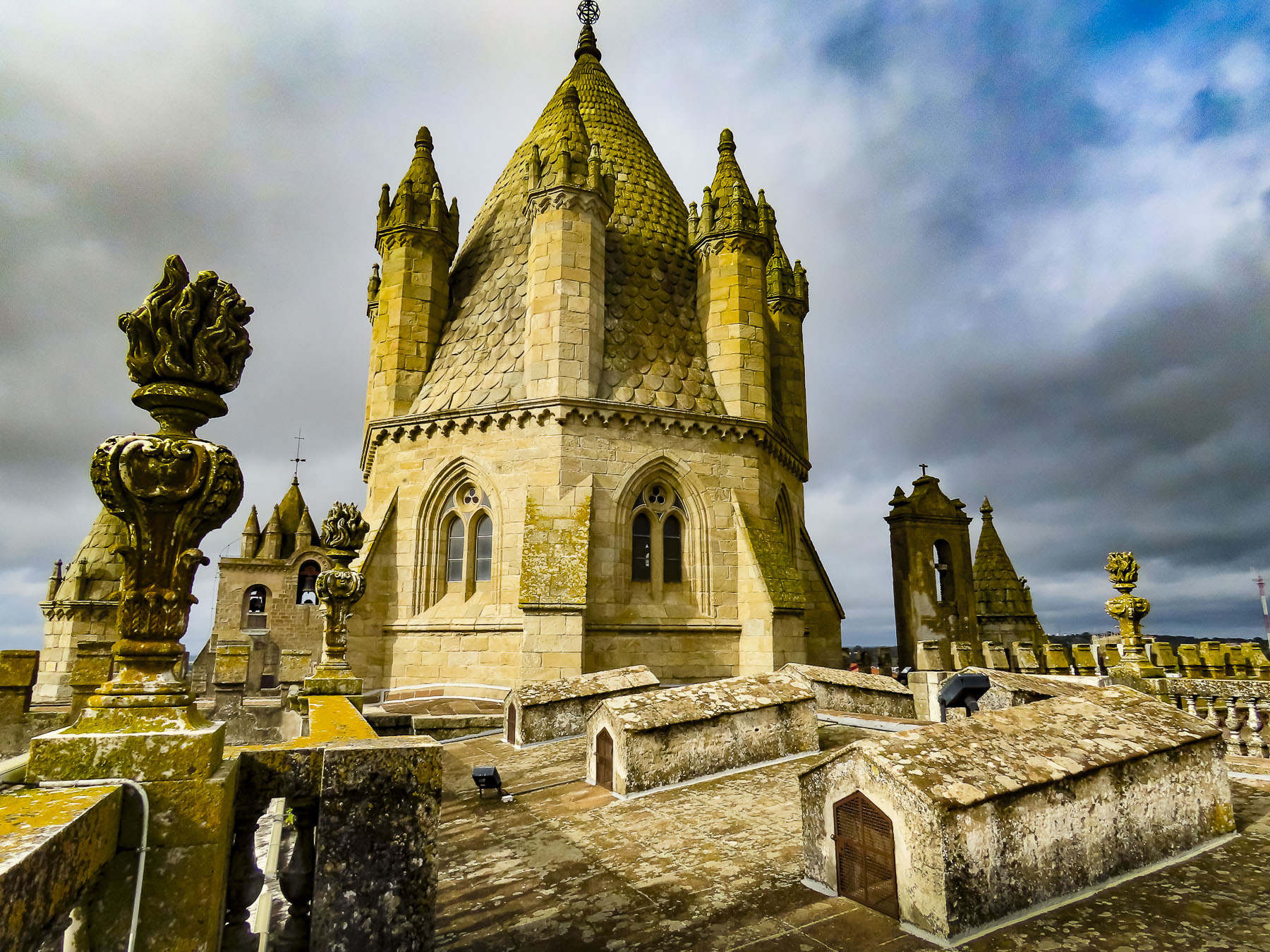
The cloister attached to the cathedral now houses a museum exhibiting the church’s ecclesiastical treasures, displayed in spaces that were once monks’ cells.
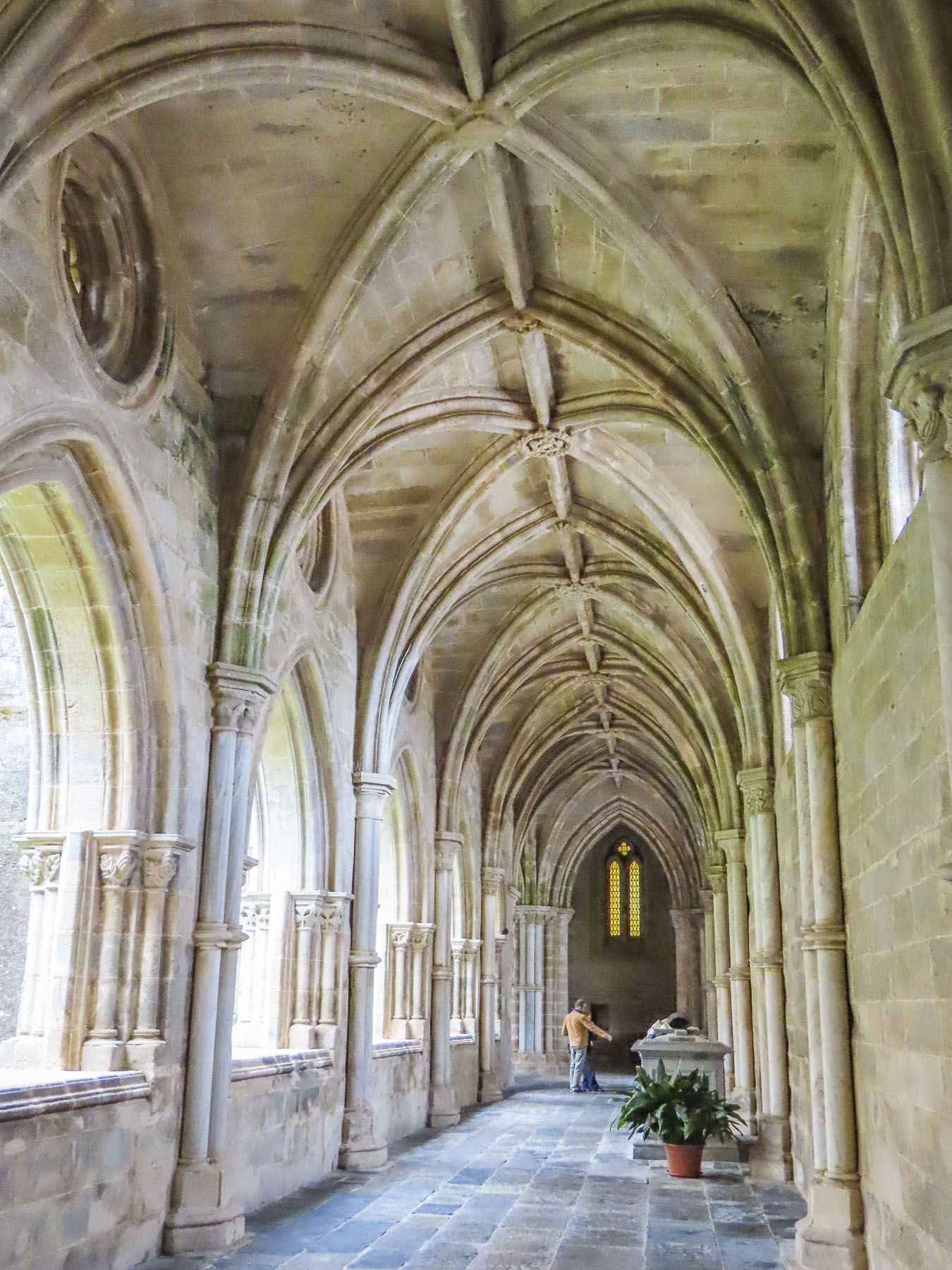
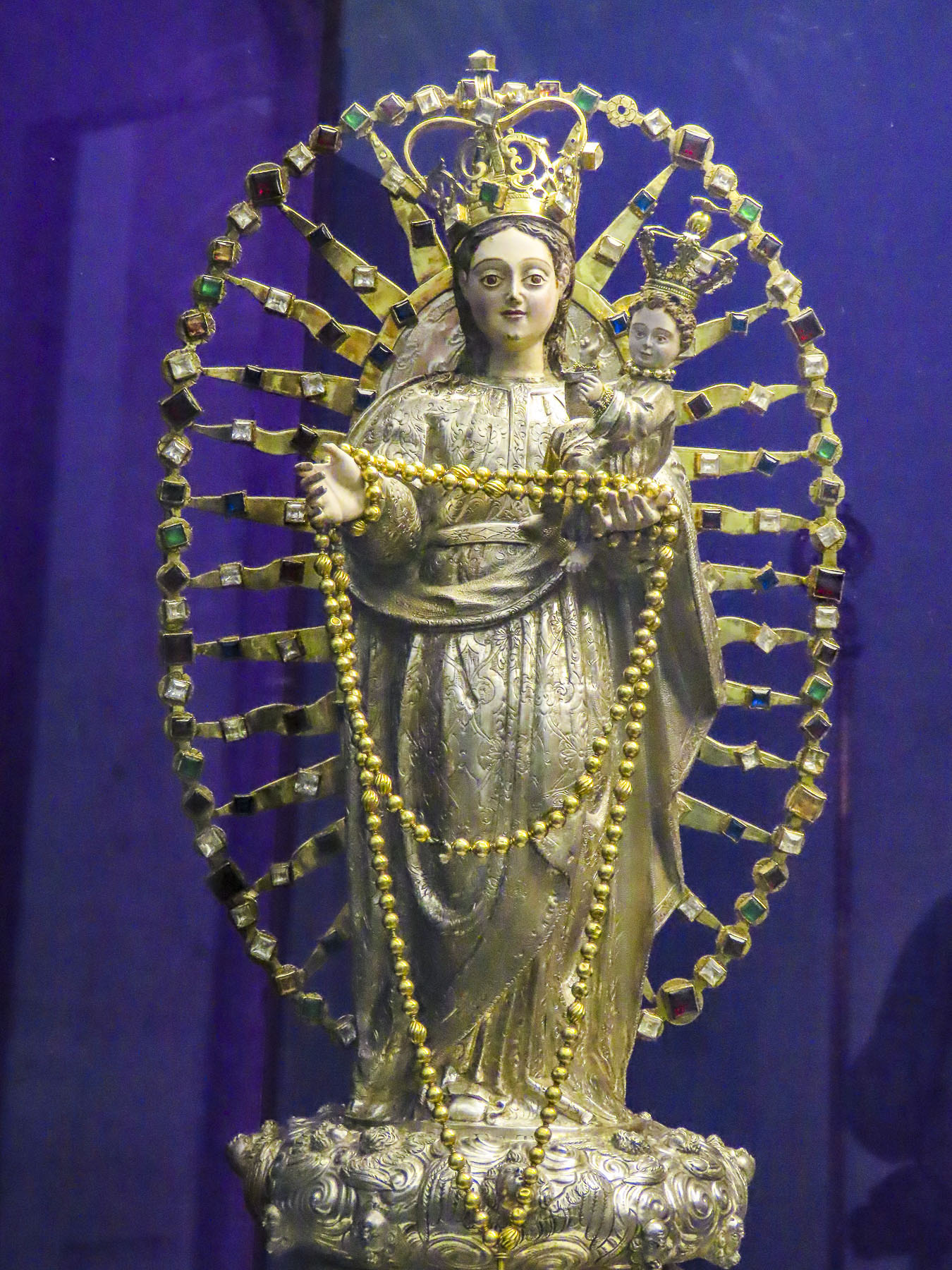



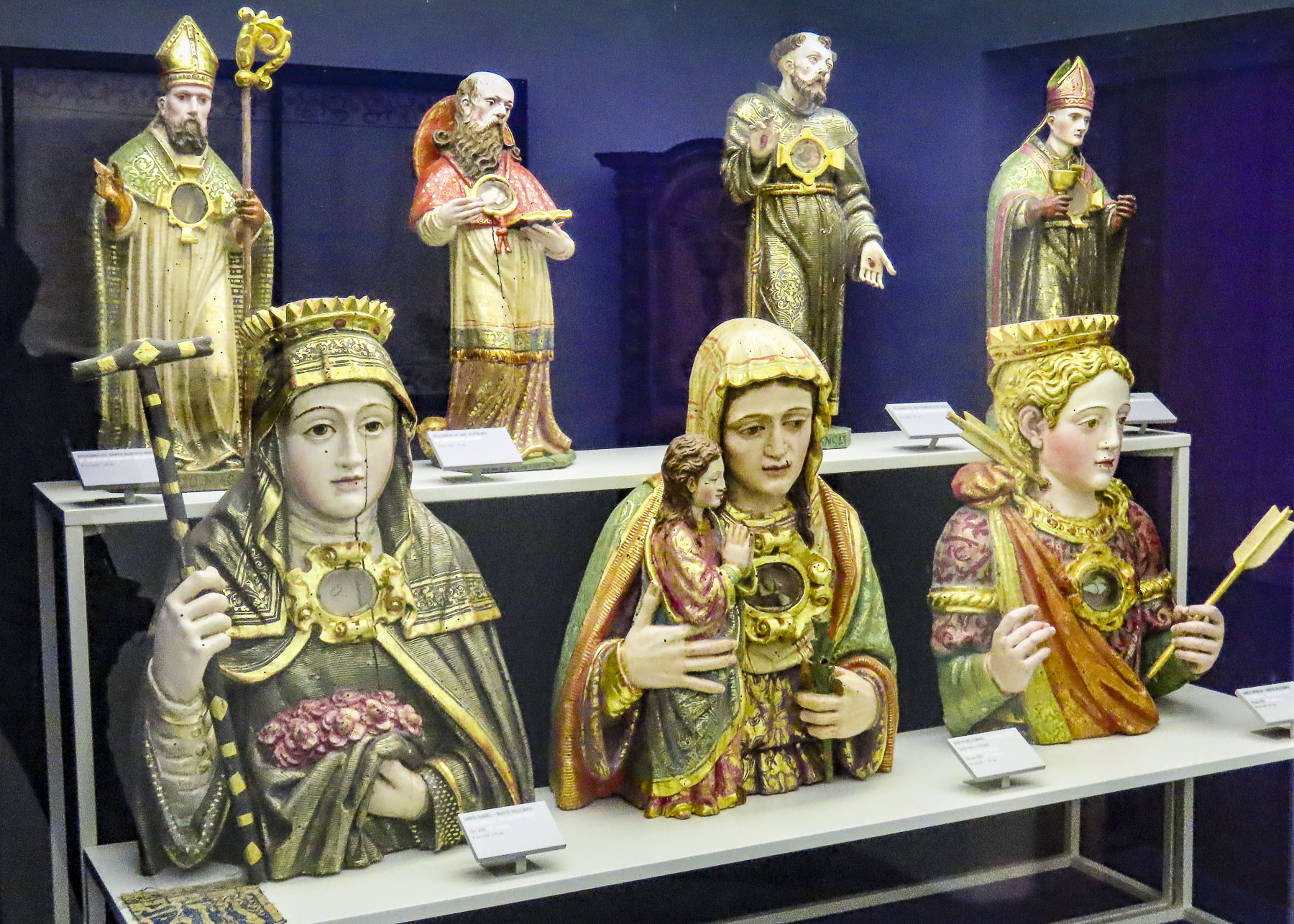

The Miradouro do Jardim Diana at the other end of the acropolis was a fine spot for a café break and also people watching.

Wine tastings featuring Alentejo vintages produced in the region surrounding Evora are a popular activity within the city. It’s not really our thing, but on the spur of the moment we stopped in the Ervideira Wine Shop, made a reservation, and returned later for a private wine tasting. Our knowledgeable host walked us through a tasting of five delightful Ervideira vintages. It was a very enjoyable experience and we purchased two bottles to accompany us to the Algarve.


Luckily, we were strolling along the arcade covered sidewalk that parallels Praça do Giraldo when the sky burst open with a sudden downpour. The timing was perfect as we had stopped in front of the Cafe Arcada, which was packed with locals eager to take part in its sumptuous lunch buffet. It’s definitely worth checking out and very budget friendly.



Walk a little then café is the philosophy we follow when exploring a city. With that in mind we continued the next morning to wander our way slowly towards the museum of the Igreja e Mosteiro de São Francisco and next to it – cue creepy music – the Capela dos Ossos, Evora’s Chapel of Bones.




“Nos ossos que aqui estamos pelos vossos esperamos.” It’s hoped this odd welcoming inscription, translated as “We bones that are here, for your bones we wait,” above the entrance to the ossuary will lead visitors to contemplate the ephemeral nature of life. Attached to the Mosteiro de São Francisco, the bones chapel was built by three Franciscan monks in the late 1400s as a way to respectfully reintern 5000 dead that were being exhumed from Evora’s overflowing cemeteries to make room for the newly departed. A wedding service was in progress at the Iglesia de São Francisco when we exited. Something old, something new. Life goes on.

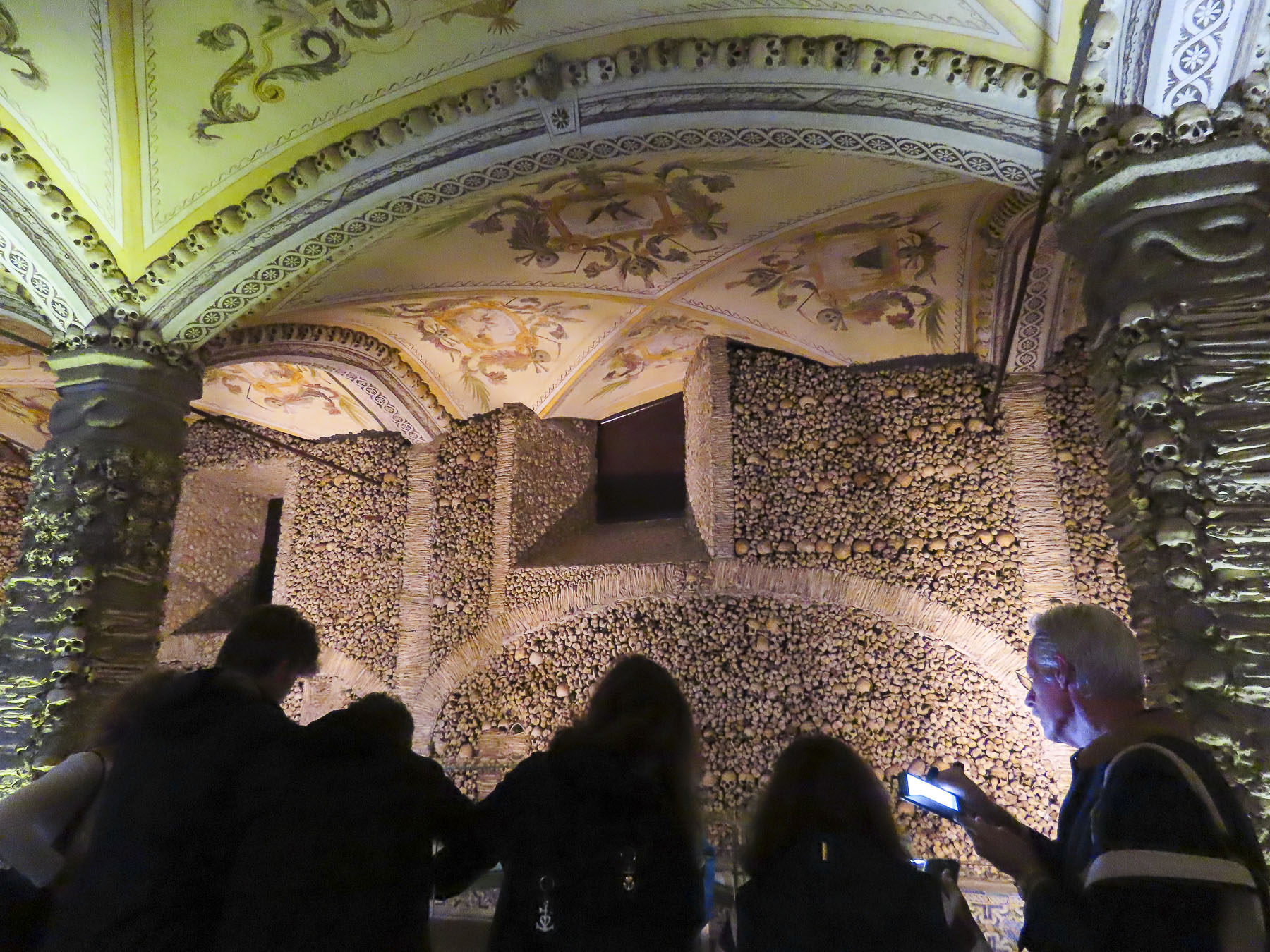
Afterwards, we crossed to the municipal market and browsed amongst the vendors for some fruit, cheese, sausage and of course irresistible Portuguese olives for a picnic lunch in the Jardim Público de Évora, only a short walk away.

Heading back into the center of the historic district we passed the Igreja da Graça. This 16th century church has a unique façade that features four, very large-muscled Atlas figures sitting on the corners of the roof. We assumed the interior would be equally as interesting, but it’s not open to visits as it is currently used as a chapel for the Portuguese Armed Forces.
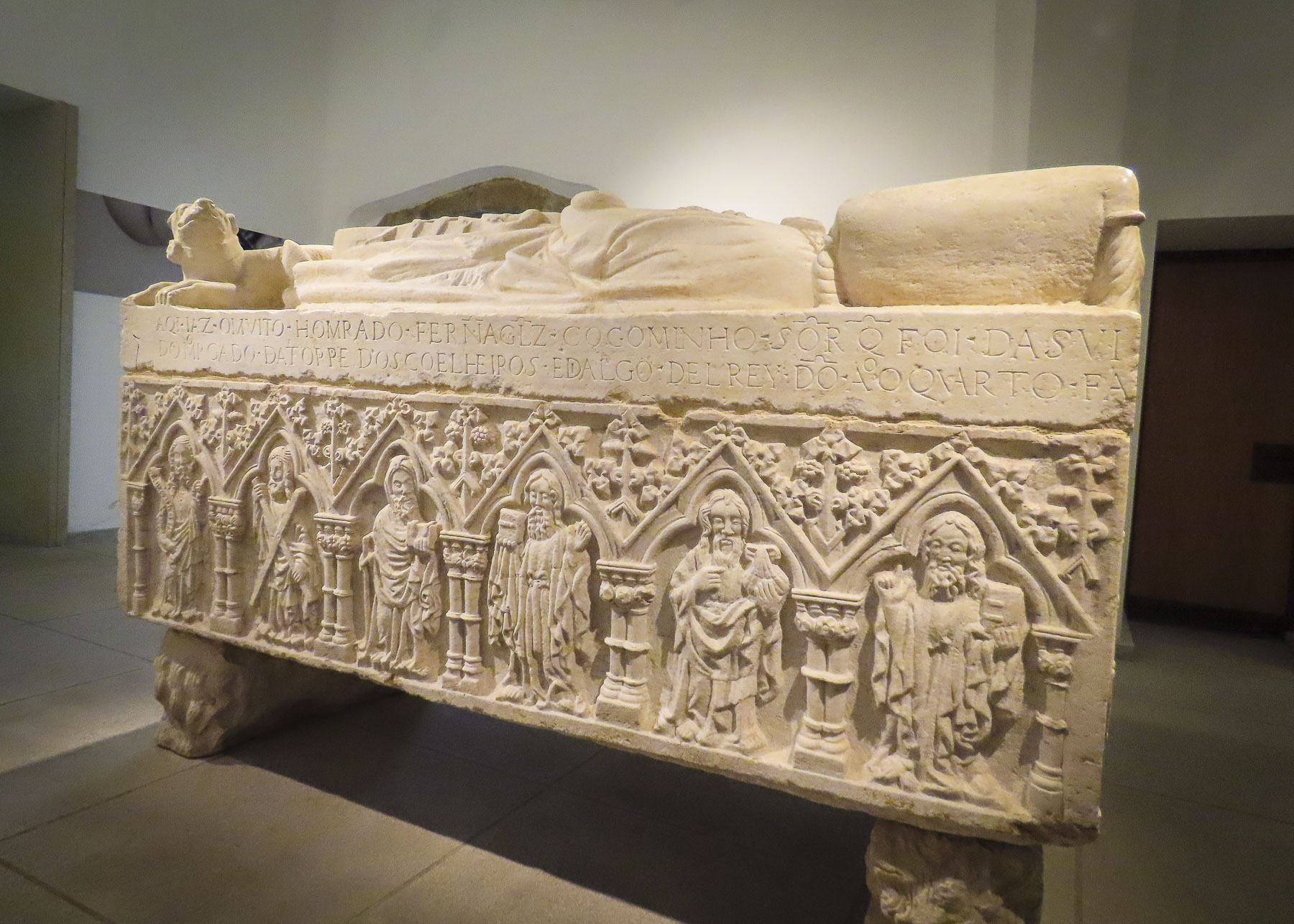



Back at the acropolis, we toured the Museum Frei Manuel do Cenáculo, named for the 18th century monk/archeologist who later became archbishop of Evora. It’s an eclectic collection featuring Roman and Visgoth antiquities gathered by Cenáculo, period furniture, and four centuries of ecclesiastical art from extinct churches of the region. It was a fascinating exhibit.

The weather was finally improving. We were ready to work on our tans. Tomorrow the Algarve.
Till next time, Craig & Donna
This website, The Historical Villages of the Portuguese Frontier might whet your curiosity to explore the region.





